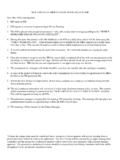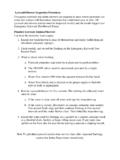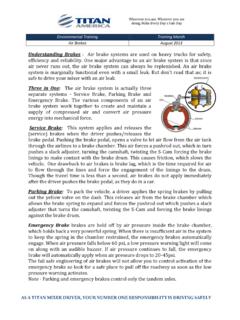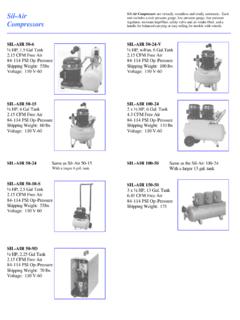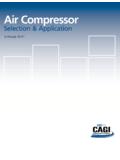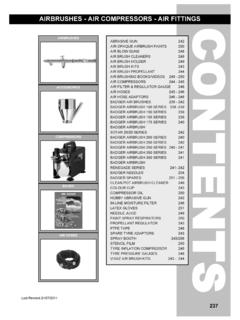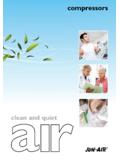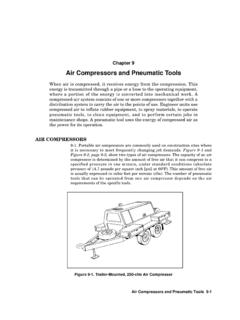Transcription of NAPA Air Compressors - Schrader Bridgeport …
1 NAPA Air Compressors - Schrader Bridgeport international , Inc. ======================================== ================================= Material Safety Data Sheet compressor OIL ISO 100 ======================================== ================================= Telephone Number (24 Hour Emergency Assistance): Chemtrec: 800-424-9300 Name & Address Rost Group, 2775 22 & 3, Suite 8, Maineville, OH 45309 ======================================== ================================= Section I - Name Product: compressor Oil ISO 100 Chemical Name.
2 Hydrotreated Heavy Paraffinic Distillate Chemical Family: Petroleum Hydrocarbon: Base Stock Health Hazard: 1 Fire Hazard: 1 Reactivity: 1 ======================================== ================================= Section II - Product/Ingredient No. Composition Cas No. Percent P compressor ISO 100 1 Hydrotreated Heavy Parffinic Distiallate 64742-54-7 100 NFPA HAZARD RATING: HEALTH 0 FIRE 1 REACTIVITY 0 ======================================== ================================= Section III - Health Information The health effects noted below are consistent with requirements under the OSHA hazard communications standard (29 CFR ).
3 EYE CONTACT:Based on essentially similar product testing product is considered practically non-irritating to the eyes. SKIN CONTACT: Based on essentially similar product testing, product is considered slightly irritating to the skin. Prolonged and repeated contact may lead to various skin disorders such as dermatitis, oil acne, or folliculitis. INHALATION: The inhalation of vapors (generated at high temperatures only) or oil mist may cause a mild irritation of the mucous membranes of the upper respiratory tract. INGESTION: Based on essentially similar product testing product is considered no more than slightly toxic if swallowed.
4 SIGNS AND SYMPTOMS: Irritation as noted above. AGGRAVATED MEDICAL CONDITIONS:Pre-existing skin conditions and respiratory disorders may be aggravated by exposure. OTHER HEALTH EFFECTS:This product and its components are not classified as carcinogens by international Agency for Research on Cancer (IARC). National toxicology program (NTP) or Occupational Safety and Health Administration (OSHA). ======================================== ================================= Section IV - Occupational Exposure Limits COMP NO. PEL/TWA PEL/CEILING TLV/TWA ACGIH TLV/STEL OTHER P 5 MG/M3* NONE 5 MG/M3* 10 MG/M3* *Oil mist, mineral ======================================== ================================= Section V - Emergency and First Aid Procedures EYE CONTACT: Flush with Water.
5 If irritation occurs, get medical attention. SKIN CONTACT: Remove contaminated clothing and wipe off excess with soap and water or a waterless and cleaner followed by soap and water. If irritation occurs, get medical attention. INHALATION: Remove victim to fresh air and provide oxygen if breathing is difficult. Get medical attention. NOTE TO PHYSICIAN: In general, emesis induction is unnecessary in high viscosity,low volatility products, I. E., most oils and greases. ======================================== ================================= Section VI - Supplemental Health Information None Identified ======================================== ================================= Section VII - Physical Data BOILING POINT (Deg F) SPECIFIC GRAVITY (H2O = 1) VAPOR PRESSURE (MMM HG) >530 < MELTING POINT(DEG F) SOLUBILITY IN WATER VAPOR DENSITY (AIR = 1) 5 (Four Point) Negligible Not available Viscosity 430-600 SUS @ 100 Deg F EVAPORATION RATE (Normal Butyl Acetate - 1)
6 Not available APPEARANCE and ODOR: Amber liquid. Slight hydrocarbon odor. PHYS/CHEM PROPERTIES: See above details. ======================================== ================================= Section VIII - Fire and Explosion Hazards FLASH POINT METHOD: 450 Deg F (COC) FLAMMABLE LIMITS/PERCENT VOLUME IN AIR: Lower N/AV Higher N/AV EXTINGUISHING MEDIA: Use water fog, foam, dry chemical or CO2. Do not use a direct stream of water. Product will float and can be reignited on surface of water. SPECIAL FIRE FIGHTING PROCEDURES AND PRECAUTIONS: Material will not burn unless preheated.
7 Do not enter confined fire-space without full bunker gear (helmet with face shield, bunker coats, gloves and rubber boots), including a positive-pressure niosh-approved self contained breathing apparatus. Cool fire exposed containers with water. UNUSUAL FIRE AND EXPLOSION HAZARDS: None identified ======================================== ================================= Section IX - Reactivity STABILITY: Stable Hazardous polymerization will not occur CONDITIONS AND MATERIALS TO AVOID: Avoid heat, open flames and oxidizing materials.
8 HAZARDOUS DECOMPOSITION PRODUCTS: Thermal decomposition products are highly dependent on the combustion conditions. A complex mixture of airborne solid, liquid, particulates and gases will evolve when this material undergoes pybolysis or combustion. Carbon monoxide and other unidentified organic compounds may be formed upon combustion. ======================================== ================================= Section X - Employee Protection RESPIRATORY PROTECTION: If exposure may or does exceed occupational exposure limits (Section IIV) use a niosh-approved respirator to prevent overexposure.
9 In accord with 29 CFR use either an atmosphere supplying respirator or an air-furifying respirator for organic vapors and particulates. PROTECTIVE CLOTHING: Wear chemical resistant gloves and other protective clothing as required to minimize skin special eye protection is routinely necessary. Test data from published literature and/or glove and clothing manufactures indicate the best protection is provided by nitrile gloves ADDITIONAL PROTECTIVE MEASURES: None identified ======================================== ================================= Section XI - Environmental Protection SPILL OR LEAK PROCEDURES: May burn although not readily ignitable.
10 Use cautious judgement when cleaning up large spills. **Large Spills:Wear respirator and protective clothing as off source of leak if safe to do so. Dike and contain. Remove with vaccum trucks or pump to storage/salvage up residue with an absorbent such as clay, sand, or other suitable materials. Dispose of area with water to remove trace residue. **Small Spills:Take up with an absorbent material and dispose of properly. ======================================== ================================= Section XII - Special Precautions Minimize skin contact.



